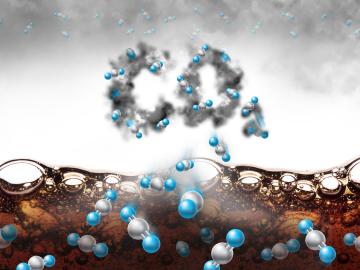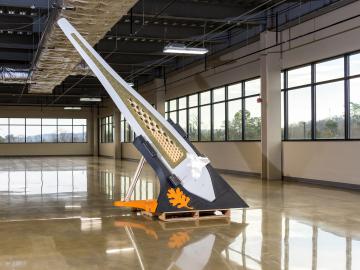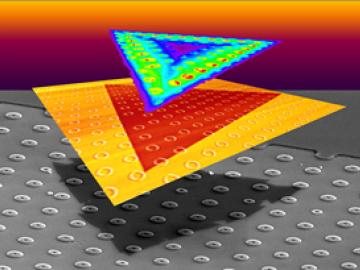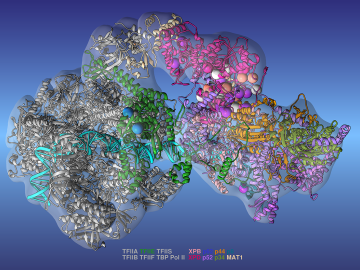
Filter News
Area of Research
- (-) Isotope Development and Production (1)
- (-) Materials (108)
- (-) Supercomputing (96)
- Advanced Manufacturing (22)
- Biology and Environment (33)
- Building Technologies (1)
- Computational Biology (2)
- Computational Engineering (2)
- Computer Science (9)
- Electricity and Smart Grid (3)
- Energy Science (186)
- Functional Materials for Energy (1)
- Fusion and Fission (11)
- Fusion Energy (3)
- Isotopes (2)
- Materials Characterization (1)
- Materials for Computing (19)
- Materials Under Extremes (1)
- National Security (27)
- Neutron Science (40)
- Nuclear Science and Technology (6)
- Quantum information Science (1)
- Sensors and Controls (1)
- Transportation Systems (2)
News Topics
- (-) 3-D Printing/Advanced Manufacturing (26)
- (-) Artificial Intelligence (39)
- (-) Grid (9)
- (-) Materials Science (84)
- (-) Summit (43)
- (-) Transportation (19)
- Advanced Reactors (5)
- Big Data (22)
- Bioenergy (18)
- Biology (14)
- Biomedical (22)
- Biotechnology (2)
- Buildings (8)
- Chemical Sciences (32)
- Clean Water (3)
- Composites (9)
- Computer Science (99)
- Coronavirus (17)
- Critical Materials (15)
- Cybersecurity (8)
- Energy Storage (37)
- Environment (35)
- Exascale Computing (26)
- Frontier (32)
- Fusion (8)
- High-Performance Computing (45)
- Irradiation (2)
- Isotopes (14)
- ITER (1)
- Machine Learning (15)
- Materials (79)
- Mathematics (2)
- Microscopy (29)
- Molten Salt (3)
- Nanotechnology (42)
- National Security (8)
- Neutron Science (42)
- Nuclear Energy (21)
- Partnerships (11)
- Physics (34)
- Polymers (18)
- Quantum Computing (21)
- Quantum Science (33)
- Security (7)
- Simulation (16)
- Software (1)
- Space Exploration (6)
Media Contacts

Oak Ridge National Laboratory has teamed with Cornell College and the University of Tennessee to study ways to repurpose waste soft drinks for carbon capture that could help cut carbon dioxide emissions.

A team of researchers at Oak Ridge National Laboratory have demonstrated that designed synthetic polymers can serve as a high-performance binding material for next-generation lithium-ion batteries.

In the shifting landscape of global manufacturing, American ingenuity is once again giving U.S companies an edge with radical productivity improvements as a result of advanced materials and robotic systems developed at the Department of Energy’s Manufacturing Demonstration Facility (MDF) at Oak Ridge National Laboratory.

Scientists have discovered a way to alter heat transport in thermoelectric materials, a finding that may ultimately improve energy efficiency as the materials

A team led by scientists at the Department of Energy’s Oak Ridge National Laboratory explored how atomically thin two-dimensional (2D) crystals can grow over 3D objects and how the curvature of those objects can stretch and strain the

Environmental conditions, lifestyle choices, chemical exposure, and foodborne and airborne pathogens are among the external factors that can cause disease. In contrast, internal genetic factors can be responsible for the onset and progression of diseases ranging from degenerative neurological disorders to some cancers.

OAK RIDGE, Tenn., May 7, 2019—Energy Secretary Rick Perry, Congressman Chuck Fleischmann and lab officials today broke ground on a multipurpose research facility that will provide state-of-the-art laboratory space

Using Summit, the world’s most powerful supercomputer housed at Oak Ridge National Laboratory, a team led by Argonne National Laboratory ran three of the largest cosmological simulations known to date.

In a step toward advancing small modular nuclear reactor designs, scientists at Oak Ridge National Laboratory have run reactor simulations on ORNL supercomputer Summit with greater-than-expected computational efficiency.

Using artificial neural networks designed to emulate the inner workings of the human brain, deep-learning algorithms deftly peruse and analyze large quantities of data. Applying this technique to science problems can help unearth historically elusive solutions.


